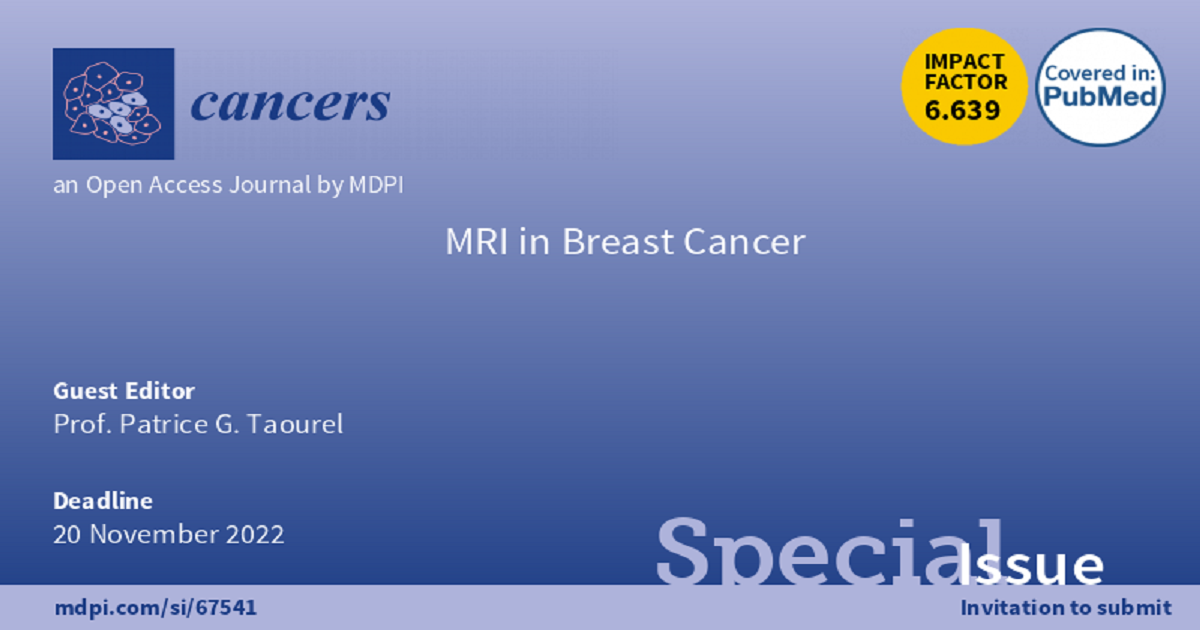MRI in Breast Cancer
A special issue of Cancers (ISSN 2072-6694).
Deadline for manuscript submissions: closed (20 November 2022) | Viewed by 10318

Special Issue Editor
Special Issue Information
Dear Colleagues,
Breast cancer is one of the leading malignancies for new diagnoses as well as for cancer-related mortality. Over the past decade, the diagnosis and management of breast cancer has undergone marked changes, with a growing role of diagnostic and interventional MRI.
When it comes to MRI screening, familial risk factors, personal history of breast cancer, genomic testing, and imaging factors such as the beast density at mammography and background parenchymal enhancement at MRI are useful tools to better stratify risk prognostication and potentially individualize imaging screening strategies, including MRI. The role of abbreviated and ultrafast breast MRI in this indication must be assessed more extensively.
For the characterization of breast tumor and axillary lymph node, MRI radiomics, notably including shape features, kinetic intensity-histograms, and texture matrix-based features, bears the advantage of non-invasively quantifying the underlying phenotype of the entire tumor in contrast to tissue biopsy, which samples only a small part of a potentially heterogeneous tumor. However, biopsy under MRI guidance remains the reference exam when suspicious lesions are visible on MRI only, and we need more experience focused on the way of improving the diagnostic management of enhancement detected by MR.
For the locoregional management of breast cancer, MRI allows mapping the extent of the disease to guide surgery, and to guide management of axillary lymph nodes. However, the impact of breast MRI on the rate of multistage surgery and on the rate of recurrence is still discussed.
In the follow-up of patients with breast cancer, MRI permits to monitor the response of breast cancer after neo-adjuvant chemotherapy. Its usefulness for the assessment of the intermediate response and its impact on the surgical gesture according to the delayed response remains a topic of interest.
Lastly, the role of artificial Intelligence in detecting breast lesions on MRI and in the task of differentiating benign and malignant enhancing lesions detected at breast MRI is a fast-developing topic and will have a considerable impact on breast imaging.
For this Special Issue of Cancers, we welcome articles of different types—mini-reviews, full reviews, and data articles to address these different issues with the aim of better defining the place of MRI in breast cancer.
Prof. Patrice G. Taourel
Guest Editor
Manuscript Submission Information
Manuscripts should be submitted online at www.mdpi.com by registering and logging in to this website. Once you are registered, click here to go to the submission form. Manuscripts can be submitted until the deadline. All submissions that pass pre-check are peer-reviewed. Accepted papers will be published continuously in the journal (as soon as accepted) and will be listed together on the special issue website. Research articles, review articles as well as communications are invited. For planned papers, a title and short abstract (about 100 words) can be sent to the Editorial Office for announcement on this website.
Submitted manuscripts should not have been published previously, nor be under consideration for publication elsewhere (except conference proceedings papers). All manuscripts are thoroughly refereed through a single-blind peer-review process. A guide for authors and other relevant information for submission of manuscripts is available on the Instructions for Authors page. Cancers is an international peer-reviewed open access semimonthly journal published by MDPI.
Please visit the Instructions for Authors page before submitting a manuscript. The Article Processing Charge (APC) for publication in this open access journal is 2900 CHF (Swiss Francs). Submitted papers should be well formatted and use good English. Authors may use MDPI's English editing service prior to publication or during author revisions.
Keywords
- breast cancer
- screening
- staging
- follow-up
- MRI
Benefits of Publishing in a Special Issue
- Ease of navigation: Grouping papers by topic helps scholars navigate broad scope journals more efficiently.
- Greater discoverability: Special Issues support the reach and impact of scientific research. Articles in Special Issues are more discoverable and cited more frequently.
- Expansion of research network: Special Issues facilitate connections among authors, fostering scientific collaborations.
- External promotion: Articles in Special Issues are often promoted through the journal's social media, increasing their visibility.
- Reprint: MDPI Books provides the opportunity to republish successful Special Issues in book format, both online and in print.
Further information on MDPI's Special Issue policies can be found here.






